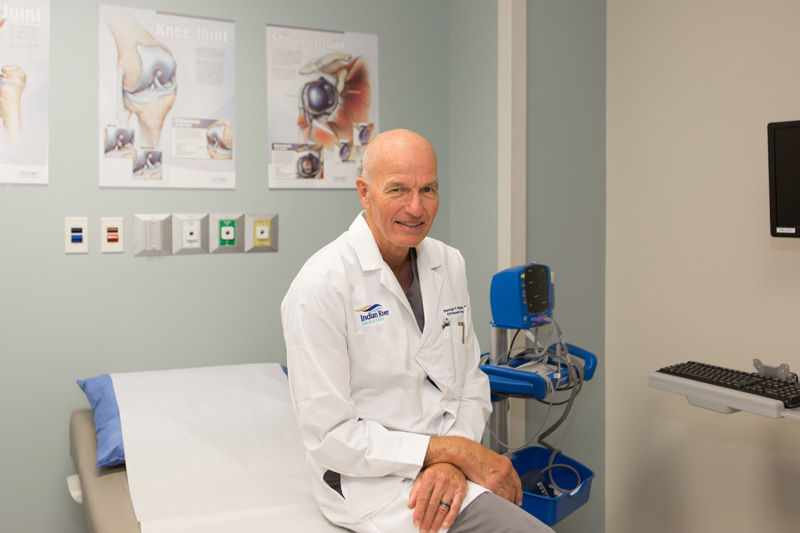It’s just a fact of life: As we age, parts of our bodies can simply wear out. Hips, knees and shoulders are prime examples.
Fortunately, it’s another fact of modern life that all three of those essential joints can be replaced, and Dr. George Nichols at the Indian River Medical Center has about as much experience doing that as anyone, anywhere.
Nichols, who earned his medical degree at the University of Maryland and later served as a clinical instructor for the department of orthopedic surgery at the Yale School of Medicine, says, “I’ve probably done 6,000 knees and about 5,000 hips and I don’t even know how many shoulders.”
The former section chief of IRMC’s orthopedic department, Nichols just opened new offices here inside the hospital’s “patient pavilion.” After 31 years in Vero, he is still going strong, running in marathons and participating in ironman competitions. That’s not bad for a man who has had both hip and shoulder replacement surgery himself.
According to the Agency for Healthcare Research and Quality, about 53,000 people in the U.S. now have shoulder replacement surgery each year.
“The shoulder,” Nichols explains, “unlike the hip or the knee, is not a weight-bearing joint, so you don’t use your shoulder as much . . . so there’s not as many shoulders that are done. Number-wise, I probably do 100 shoulders a year compared to probably 300 knees and probably 150-200 hips.”
Those shoulder numbers, however, appear to be trending upward.
“For some reason,” Nichols interjects, “I’m seeing a whole lot more people with shoulder problems now. I’m just seeing more and more.”
The most likely culprit, according to Nichols and The American Academy of Orthopedic Surgeons, is osteoarthritis which Nichols says “is the most common form of arthritis.”
Leaning forward in one of his exam rooms, Nichols puts his dry sense of humor on display. When patients ask him why they got osteoarthritis in the first place, he tells them, “It’s because they just picked some bad parents,” meaning genetic susceptibility plays a big role.
The shoulder is made up of three bones: the upper arm bone or humerus; the shoulder blade or scapula; and the collarbone or clavicle.
The shoulder joint is a ball-and-socket structure. The ball at the top of the upper arm fits into a shallow socket in the shoulder blade.
Ideally, the surfaces of these bones are covered with cartilage that enables them to glide and move easily. A thin, smooth membrane covers all the remaining surfaces inside the joint, further reducing friction.
“This,” says the AAOS, “allows the shoulder to rotate through a greater range of motion than any other joint in the body.”
When it’s healthy.
Osteoarthritis, however, deteriorates and wears away the cartilage that cushions those bones, causing stiffness at first and then severe pain throughout the entire shoulder. It is most common in people over 50 and tends to get worse with age.
Other diseases and conditions that can cause a need for surgical shoulder replacement include rheumatoid arthritis, rotator cuff tears and trauma from severe fractures – all of which can lead to severe loss of mobility in the shoulder and excruciating pain.
Says Nichols: “Rheumatoid arthritis is the second most common type of arthritis that we see. That is because the cartilage gets eaten away,” and again creates the kind of friction and pain caused by osteoarthritis.
In a shoulder replacement surgery, doctors remove the damaged ends of the bones affected and, using plastic or metallic parts, create a new friction-free joint.
The new parts may be held in place with bone cement, a substance remarkably similar to fiberglass, or the surgeon may opt to use a “porous coating” material which allows new bone to grow over time and hold the new pieces in place without the cement.
A newer procedure, known as “reverse total shoulder replacement,” takes a slightly different route. Nichols says “I was one of the first people on the east coast of Florida to do a reverse shoulder, probably 15 years ago.”
The reverse shoulder procedure, Nichols explains, “is where we put the ball where the socket is and we put the socket where the ball is.” Under certain circumstances, Nichols says, this procedure holds the new joint in place better.
Like any surgeon, Nichols is always concerned with possible post-surgical complications including infections but happily reports that, statistically, “shoulder surgery is much less likely” to see infections than either hip or knee procedures.” He adds that “patient satisfaction is much higher with shoulder replacements as opposed to hip or knee surgery.”
Dr. George Nichols’ offices are located in the Patient Pavilion at IRMC, right next to the hospital’s Emergency Room entrance at 1000 36th Street Vero Beach. The phone number is 772-794-1444.

